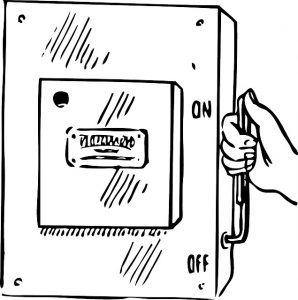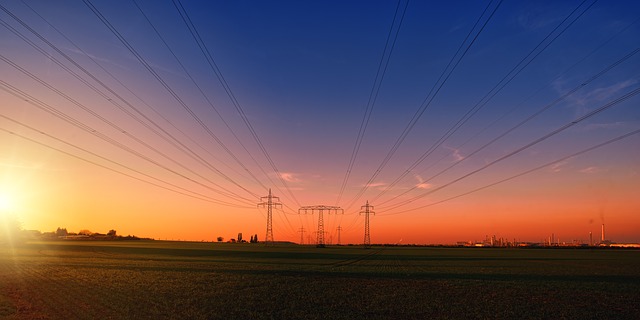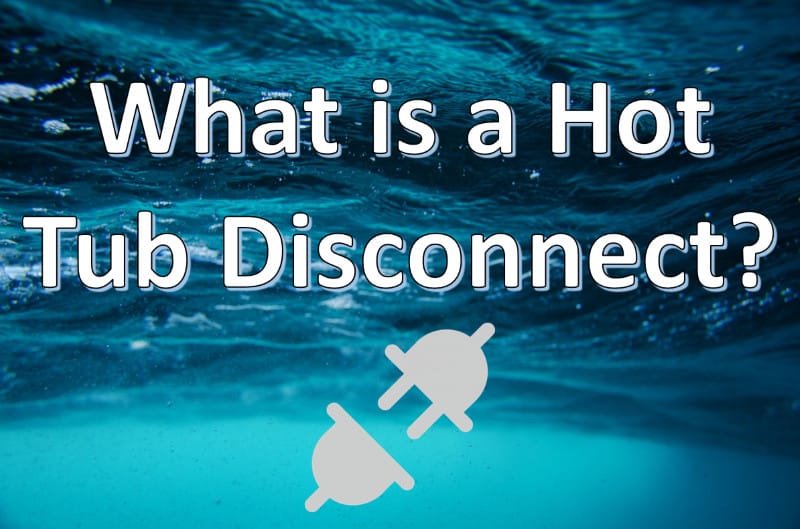What is a hot tub disconnect?
A hot tub disconnect is a unique electrical component installed for the 220-V hot tubs for different reasons. First, it facilitates drawing more electrical energy for rapid water heating. A hot tub disconnect is a small breaker box for quick disconnection of the power when there is danger or a faulty electrical connection.
Stop wasting time and money with hot tub maintenance and confusing water chemistry! The Hot Tub Handbook and Video Course will help keep your hot tub balanced, sanitized, and crystal clear all the time.
Check out my list of high-quality hot tub products to help keep your hot tub clean and running great all year long!
I recommend the AstroAI Digital Multimeter for testing electrical issues with your spa.
When I first bought my hot tub, I wasn’t fully aware of all the electrical requirements it required. One of those requirements is a hot tub disconnect.
I did a bit of research and this is what I found…
The 110-V model relies on power from the regular electricity supply. It is commonly called the plug-and-play model. The 110-V models do not support running the hot tub jets on high. But the 220-V models do.
The aim of writing this article is to help you understand what a hot tub disconnect is.
Let’s get started!
What is a Hot Tub Disconnect?
I have seen that different hot tubs connect to your home’s electricity in different ways. The question of, “what is a hot tub disconnect?” comes if you are an owner and a user of a 220-V system.
A hot tub disconnect is a small breaker box that allows quick disconnection of power from the hot tub. It also helps provide some extra security by cutting off the power when there is any form of danger or error in the electrical connections.
If you use a hot tub disconnect, heating the hot tub water is much faster. The breaker box is usually located not less than five feet from the hot tub.
Unlike the 220-V models, the 110-V models of hot tubs will be plugged into the power directly and start functioning. But you must install the breaker box with the 220-V models close to the supply system. I usually recommend you avoid locating the breaker box too close to the hot tub so that it can remain safe from splashing.
Check out our article on keeping a hot tub turned on all the time for more information on hot tub maintenance.
Does a Hot Tub Need a Disconnect?
Yes, if it is a 220-V model, and no if it is a plug-and-play model. It is only the 220-V model that requires a lot of power, thus needs some extra electrical works to be carried out to install the breaker box.
The two common hot tub disconnects are in the capacities of 50 and 60 amps. But there is higher amperage for the larger hot tubs whose capacity is seven people or more. But these models are not common.
The 50-amp capacity is the most common and usually sufficient for most of the available 220-V hot tubs. However, you can use a higher amperage if you own a larger hot tub or live in a cooler region. But your decision should be guided by the owner’s manual to know the recommended amperage for your chosen model.
I recommend this 60-Amp, 240-Volt electrical safety switch from Schneider Electric.

Stop wasting time and money with hot tub maintenance and confusing water chemistry! Get Instant access to this easy-to-use book and video course so you can spend less time cleaning and more time soaking.
Learn MoreDoes a Hot Tub Disconnect Need a Ground Rod?
No. Grounding a hot tub is prohibited as the only return path. It acts as a poor conductor of electricity where the voltage level is below 600V.
The effects of using a ground rod would be the electrification of the ground around the hot tub. This increases the risk of causing electrocution. Specifically, you could be electrocuted if you were standing on the ground beside the spa.
When the object you’re touching is properly grounded, you will conduct electricity from the electrified ground through your body and out to the object you’re holding.
The only area where a grounding rod is allowed is the main panel alone. The main panel’s role is to limit the imposed voltage on the entire electrical system by line surges, lightning, or unintentional contact with the higher voltage lines. Therefore, ensure you keep yourself and the people around you safe.
How Do I Disconnect The Power To My Hot Tub?
It’s easy to disconnect the power from your hot tub. You need to locate the breaker switch in the electrical box and switch it off. But if you are using the 110-V model of a hot tub, you’ll only unplug the power cord from the main supply on the wall. However, you may need an electrician to help you disconnect the hot tubs directly to the wall.

How Close Can a Disconnect Be To a Hot Tub?
A hot tub disconnect is no less than 5 feet from the hot tub and no further than 50 feet. It is recommended to use GFCI-protected pumps. You should also ensure to use the hot tub disconnect for shutting off all the pumps, heater, and other components inside the hot tub.
The location of the GFCI may not be closer than 3 meters from the hot tub location. There are no codes that guide the best location for a hot tub disconnect for the residential hot tubs. I find most people using the motor disconnect codes. However, this code states that if the disconnect is lockable within a position, there’s no point in keeping it within sight.
How Do You Wire a Hot Tub Disconnect?
Before you start wiring a hot tub disconnect, I strongly recommend following all the available codes and ensuring that you consult an electrician for the task. After completing the task, I recommend calling for an inspection before you start using the hot tub.
Check out this great guide from Home Depot on wiring up a hot tub.
Electricity is dangerous when it comes into contact with water. To avoid electrocution, ensure that you fill the hot tub only after being inspected.
Most of the codes will usually require installing the hot tubs at a proximity of 10 feet from the overhead power lines. For your safety, ensure to get a licensed electrician to help you with doing electrical works comprehensively. But below is the step-by-step guide:
I recommend the AstroAI Digital Multimeter for testing electrical issues with your spa.
Step 1
Start by turning the power off at the breaker box.
Step 2
Mount your hot tub’s panel. Follow the guidelines attached to your hot tub’s panel while mounting the panel on your house’s wall. Ensure that its location is closer than five feet from the location of the hot tub. Make sure that it aligns with the hot tub’s sight.
The distance is important because it will minimize the chances that someone might touch the panel while soaking.
Step 3
Dig the conduit trench. While doing so, make sure that you consult your local building codes to get the appropriate depth for laying your conduit. I encourage you to consult the local utility companies to ensure that you do not cut any buried utility pipes or cables. The average recommended depth for the trenches is about 18 inches deep.
I usually recommend removing and cutting the sod carefully into manageable squares, setting it beside the trenches.
It would be best if you use a shovel for digging trenches.
Step 4
Now that your conduit is ready, you need to start running the conduit. I strongly advise you to lay your rubberized wire in the trench to the hot tub from the panel. While doing so, ensure to provide enough slack so that you do not tighten it a lot. Avoid running the conduit or the wire under your hot tub.
I also advise you to run the conduit downside your house from the hot tub disconnect if the main breaker circuit is located outside the home.
When your conduit runs under 6 feet from the disconnect panel, I advise using a non-metallic conduit or a liquid-tight flexible metal. Avoid using lengths that exceed 6 feet. I advise you to use a rigid metallic conduit if you intend to provide longer underground runs. One of the most popular materials you could consider is PVC.
Connect an indoor and an outdoor conduit by inserting an LB lifting in the hole. Ensure to hire a professional for inspecting your wiring.
Step 5
This step involves pulling the wires. I usually recommend using copper wires with thermal plastic nylon for insulation. I discourage the use of Aluminum wires. Use the six AWG copper wires for your hot tub.
I strongly encourage you to use fish tape for pulling the wires to the hot tub panel from the fitting. Make sure to leave six inches of extra wire hanging from your hot tub panel. Make sure to push the wires into the house and the breaker panel through the LB fitting. Leave about 6 feet of the extra wire hanging.
I also advise using fish tape for pulling the wire through to the hot tub through the conduit. Ensure that you leave about 6 inches of extra cables on both sides.
Step 6
The sixth step involves wiring a hot tub disconnect. You could do so by attaching the wires that lead to the hot tub. You should then attach the white, black, and red wires to the bottom of the GFCI breaker. Finish by attaching the green wire to the grounding rod.
Next, move to the wires in the breaker panel. Attach the red and the black wires on the top of the breaker to the breaker feed lugs. The white wire should be attached to the neutral line bar. Make sure that you have attached the green grounding wire to the ground rod. When wiring the panel, ensure that you have checked and followed your hot tub’s panel and wiring instructions.
Step 7
This step involves wiring the hot tub’s control panels with the wires coming out of the hot tub disconnect. Do so by following the instructions your manufacturer has assigned you.
Step 8
Here, you are required to wire your hot tub disconnect to the main breaker panel. Start by switching off the main breaker and checking that there’s no power. It’s important to note that electric power from a company will still be energized even after you turn off the breaker.
Ensure that you remain careful when you’re working in your breaker box. Attach the black and the red wires to the 240-V GFI circuit breaker and label the new circuit breaker for your hot tub.
Step 9
This is the final step of your hot tub disconnect wiring. It is also an important step because it involves inspection of the wiring by a professional. When everything is confirmed okay and safe, you can fill the hot tub with water for use.

How Do I Disconnect The Electrical From My Hot Tub?
I have already talked about the process of disconnecting power from the hot tub. The electrical disconnection is no much different because it means cutting off the power supply from the hot tub.
The process involves switching off the breaker switch at the electrical box. You can also unplug the power cord from the wall for the plug-and-play hot tub model to disconnect the electrical.
If you’re experiencing issues with your spa pumps, check out our full article on the subject!
What Are The Electrical Requirements For a Hot Tub?
There are two different hot tub models with separate electrical requirements. The first is called the plug-and-play model; this hot tub uses a 110V power supply. The second model is the conventional hot tubs that require much more electricity. The voltage required is a 220V power supply.
The plug-and-play model requires a 110V of power supply. You plug it into the electrical socket from the wall, and you’re good to go.
The second model requires 220 Voltages of electrical energy. When you choose this model, working with a certified electrician is advised because they will ensure that you have enough power supply to your hot tub. They will also run the correct wires to the hot tub from the power box. Before choosing any of the two models, make sure you understand the benefits and limitations of the selected model.
Check out this great article from Spa Depot on hot tub electrical requirements for more information.

What Size Breaker Do I Need for a Hot Tub?
The National Electrical Code (NEC) requires most full-sized hot tubs to be wired into a ground fault circuit interrupter (GFCI)-protected 220 to 240V. The circuit interrupter should have 50 to 60 amps dedicated.
Is a GFCI Breaker Required for a Hot Tub?
GFCI are the initials for the term Ground Fault Circuit Interrupter. Your hot tub requires a GCFI to disconnect the power when there is a ground fault automatically. Therefore, GFCI is required for all hot tubs.
Indeed, the law requires you to install a GFCI on any outlet supplying power to the hot tub. This includes the plug-and-play models. The 220-V models require a 50 to 60 amps breaker. But I always recommend you consult a professional electrician every time you want to wire your hot tub disconnect.
I recommend the Siemens 60 Amp, 2 Pole, 120/240V Ground Fault Circuit Interrupter.
What Is The Difference Between a Hot Tub Disconnect and a Circuit Breaker?
A hot tub disconnect is designed like an isolator. It is intended to disconnect a load/cable from a supply source to facilitate safe functioning. On the other hand, a circuit breaker is designed to facilitate opening and disconnecting the load/cable when passing the fault or normal currents.
Another difference is that a hot tub disconnect is used with the 220-V hot tub models, but the circuit breaker is used with the plug-and-play model.
What is a Hot Tub Disconnect: Conclusion

So, what is a hot tub disconnect?
I have seen that a hot tub disconnect is a unique electrical component installed for the 220-V hot tubs for different reasons. First, it facilitates drawing more electrical energy for rapid water heating. It also supports running the hot tub jets high when heating the water. A hot tub disconnect is a small breaker box for quick disconnection of the power when there is any danger or faulty electrical connections.
I have seen that a hot tub disconnect does not need a ground rod because it can electrify the ground around the hot tub. Also, the distance you can locate a disconnect from a hot tub is between 5 and 50 feet.
A hot tub can use either a 110 V or a 220 V supply. It is also important to remember that all hot tubs require a GFCI breaker.
I have also included a comprehensive step-by-step guide on how to wire a hot tub disconnect. However, I strongly recommended hiring a professional electrician for the task.
I hope this article has helped answer “what is a hot tub disconnect?”
If you’re having issues with heating your hot tub, check out our full article on the subject.
James Brockbank

Stop wasting time and money with hot tub maintenance and confusing water chemistry! Get Instant access to this easy-to-use book and video course so you can spend less time cleaning and more time soaking.
Learn More



